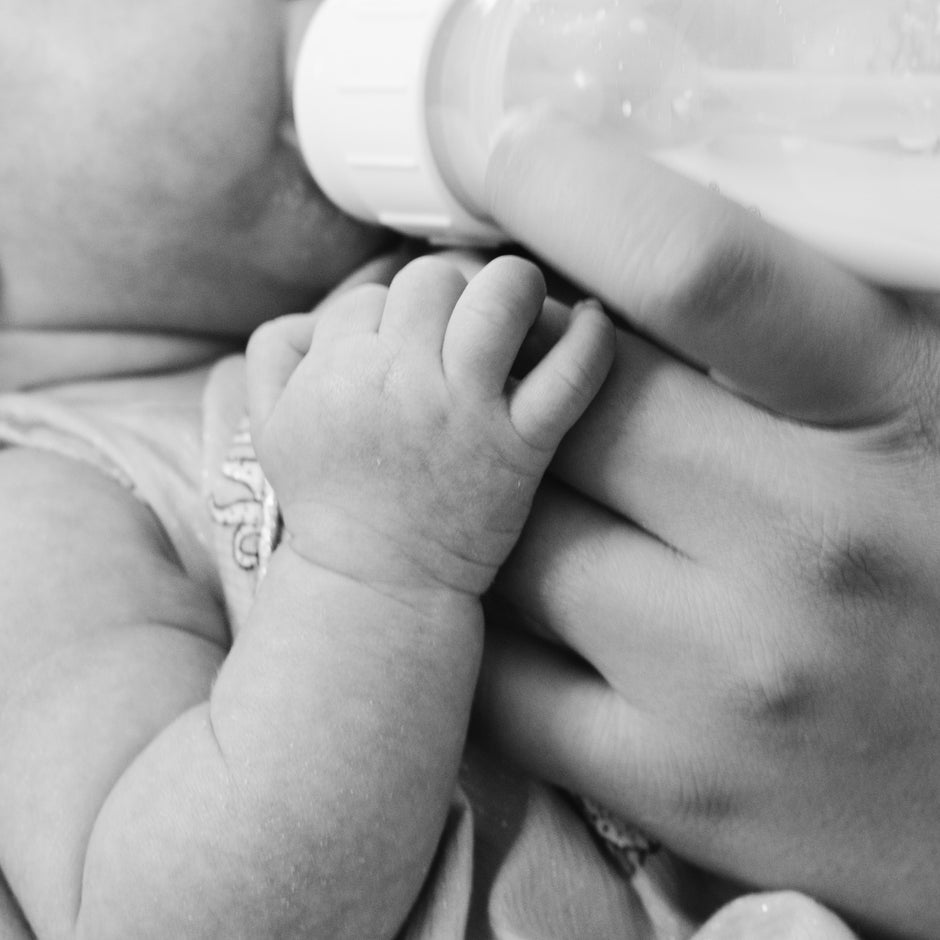Everything About the Stool of Bottle-Fed Babies
Updated on:
Photo by Kelly Sikkema on Unsplash
The diaper content of a baby who is bottle-fed looks different from that of a breastfed baby. We know this from ourselves too; the type of food naturally shapes the stool. Nevertheless, the topic greatly concerns parents. Is my baby's stool normal?
Bottle-Fed Babies Have Different Stool to Breastfed Babies
What does the stool of bottle-fed babies look like? The stool of bottle-fed babies is creamier than that of breastfed babies. Sometimes it is already formed. The color of the bowel movement ranges from light yellow to dark green - the spectrum of colors is wide. The smell is often more intense compared to the diaper contents of breastfed babies.
Are you breastfeeding your baby? We have covered the color and consistency of breast milk stool in this blog.
Everything About the Stool of Bottle-Fed Babies
Your baby is going through an incredible development. After birth, the digestive system starts working, but it is not yet fully matured. In addition, your baby might sometimes swallow too much air while feeding, which can lead to gas.
However, day by day, your baby is settling into this new world - and that includes the digestive system. Certain processes need to develop first.

Photo by @isabelplett
The Digestive System Changes
Developmental surges are part of the process and these have a major impact on digestion. This applies not only to newborns or children but also to adults. Factors like stress or travel can also cause changes in our intestines.
So, it's completely normal that your child's digestion is constantly changing in the first year. The diaper content is bound to provide some surprises during this time.
Color and Consistency of Stool in Bottle-Fed Babies
After birth, babies excrete meconium, and whether they are breastfed or bottle-fed makes no difference here. Subsequently, influenced by the type of nutrition, the stool changes.
In bottle-fed babies, the color ranges from light yellow to ochre to clay brown. However, this can also vary: Sometimes the stool is dark green in color.
The consistency also differs from the excretions of breastfed babies. While breastfed children often have a more liquid stool, that of bottle-fed babies is usually creamier or even already formed.
What Does Green Stool Mean for Bottle-Fed Babies?
There can be different reasons why a baby has green stool, but they are not worrying.
Bottle-fed babies often have green stool more frequently than breastfed babies. The discoloration can come from hydrolyzed protein in hypoallergenic (HA) formula or from the addition of iron in infant formula.
Is It Okay for a Baby's Stool to Smell?
The odor of the stool depends on the diet. Meconium, which is excreted after birth, has almost no smell. Breast milk stool smells very mild - some even describe it as aromatic.
In bottle-fed babies, however, it often smells more intense and can also be perceived as pungent.
How Often Should a Bottle-Fed Baby Have a Bowel Movement?
Bottle-fed babies typically pass stool about several times a day to at most every two days. However, this is just a guideline - after all, each baby develops slightly differently. In general, bottle-fed babies have more bowel movements than breastfed babies.
Over Time, the Number of Bowel Movements Decreases
The frequency of bowel movements is not only individual to each child but also changes over time. Initially, it could be that some stool follows every meal. As your child gets older, they will have fewer bowel movements.
This is due to development: About three to four weeks after birth, the intestines mature and can thus utilize more nutrients. The result is firmer and less frequent stool.

Photo by PublicDomainPictures from Pixabay
When Digestion Causes Discomfort
Digestive issues in infants are not uncommon. As a parent, it's difficult to endure seeing your own baby in pain. You can support your baby, but much of it is simply developmental and therefore harmless.
Constipation in Infants
Constipation can occur in newborns from time to time. If the stool is dry and hard over a longer period, this may indicate constipation.
Additives to soften the stool are not necessary as long as the baby is still drinking formula. Special milk is usually not needed either. When you start introducing solid foods, fiber-rich foods can aid digestion.
Belly Massage for Constipation and Gas
A belly massage can work wonders for constipation: Gently massage your baby's belly with a finger around the navel. This movement helps stimulate the intestines and alleviate constipation.
Alternatively, heat is also a good choice. Whether it's a cherry stone pillow or a hot water bottle - the warmth promotes digestion. This is not only helpful for constipation, but it can also reduce gas. Especially in the beginning, bottle-fed babies often swallow too much air while drinking, which then accumulates in the stomach. A good burp after feeding can help expel the air.
Hard and Dry Stool
Does your baby have to strain a lot during bowel movements and cry? This is not particularly unusual. For a newborn, it's not so easy to push out stool. This is due to processes in the digestion that have not yet perfectly adjusted. Watery stool doesn't necessarily mean diarrhea.
Creamy but firm stool is normal for bottle-fed babies. However, it can also be somewhat more liquid at times - which is absolutely normal.

Photo by @madame.vio
What Counts as Diarrhea?
Diarrhea is defined as your baby having more than five episodes of liquid stool with an unusual quantity, color, or odor within 24 hours. Other sources, however, talk about three bowel movements in 24 hours.
The reason for these different statements is simple: Babies are incredibly diverse and develop at their own pace.
Diarrhea is Harmless in Most Cases
Therefore, watery stool doesn't necessarily mean that there has to be an infection behind it. Other changes in the baby's life can disrupt the digestive system. Just like constipation, diarrhea is a part of the first year of life - but predominantly it is absolutely harmless.
As parents, we can usually rely on our intuition and our connection to the baby.
Three-Month Colic
Three-month colic refers to persistent, recurring abdominal pain in infants from about two weeks to four months old. The symptoms can vary, but they typically occur in the late afternoon or evening.
Symptoms of three-month colic include gas, cramps, restlessness, persistent crying, and difficulty falling asleep.
The Causes of Three-Month Colic
The exact causes of three-month colic are not fully understood, and it is unclear why it occurs more frequently in bottle-fed babies than in breastfed ones. Experts believe there are several factors that contribute to the development of colic:
-
Immature Digestive Systems
In newborns and young infants, the digestive system is not yet fully developed. Therefore, it may take longer to digest food, which can lead to gas and abdominal pain. -
Sensitivity to Ingredients
Some babies may be more sensitive to certain ingredients in their formula, which can cause digestive issues and colic. -
Swallowing Air
When babies swallow air while feeding, this can lead to gas and discomfort. -
General Fussiness
Some babies are naturally more fussy and sensitive to changes in their environment, which can result in colic-like symptoms.
It's important to note that three-month colic typically subsides on its own after a few weeks. While three-month colic can be very stressful for parents, it is usually harmless and does not have long-term effects on the baby's growth or health.
What Helps with Three-Month Colic
As with constipation and gas, belly massages and heat are also helpful here. You can also prepare a bottle of fennel tea. Babies often feel safer and more soothed when they are rocked or carried. Rock your baby in a swing or a sling, which helps them to relax.
A change of position can provide relief: Hold them upright while feeding to reduce pressure on the stomach.

Photo by @isabelplett
What Should I Consider When Diapering My Bottle-Fed Baby?
Judes's cloth diapers can be used from day one. Whether you breastfeed or bottle-feed your baby does not make a difference when it comes to diapering. As long as your baby is not eating solid foods, the stool remains completely water-soluble.
Hygienic and Sustainable Diapering with Judes's Cloth Diapers
To start, all you need is a cover and an inner diaper. The Poo Paper, as we at Judes call the diaper liner, can be (for now) omitted. However, some parents still use it to protect the inner diaper.
When your baby's diaper is full, it goes into the breathable diaper bag. After three to four days, this bag goes into the washing machine, where it automatically empties itself thanks to a zipper on the bottom. You can read more about the topic of washing in this blog.
This is what makes diapering with Judes's cloth diapers so straightforward. Instead of piling up plastic diapers in the trash can, you have a full diaper bag that goes into the washing machine.
Conclusion
Our digestive system undergoes significant changes after birth, with a lot happening in your baby’s belly especially in the first year of life. This also influences your baby’s bowel movements: color, consistency, smell, and amount can vary widely. The shades can range from light yellow to clay-colored to dark green. The stool of bottle-fed babies smells more intense compared to breastfed babies.
Bottle-fed babies usually have less frequent bowel movements than breastfed babies. A good rule of thumb is: Several times a day to at least every two days is normal. Their stool is firmer than that of breastfed infants. A creamy consistency is common, and the stool may also be formed already.
It may occur that your baby suffers from constipation or gas. While not pleasant, these are part of development. Gentle belly massages and warmth can help your baby.
Trust Your Intuition
As parents, this is a time when we can trust our intuition. No one knows your child better than you do, and you can often sense what they need.
Still, it's normal to feel unsettled by changes. Keep in mind when diapering that your baby is in the midst of development. This affects their digestion - whether as a child or an adult.

